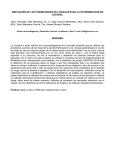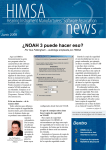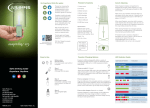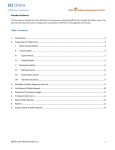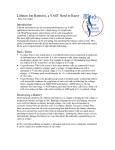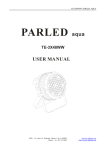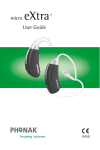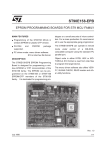Download everything you need to know
Transcript
techtopic Bringing Rechargeable Hearing Aids Into the Mainstream Market BY JERRY YANZ, PhD, JÖRG ELLESSER, MS, AND HOLGER KAEMPF, MS In their roughly 30-year history, rechargeable hearing instruments have yet to become the chosen alternative for most hearing aid wearers. This article details two new hearing systems designed to bring rechargeable hearing instruments out of the niche market and into the mainstream. S ales of rechargeable consumer electronic devices have blossomed in recent years. Surprisingly, however, in their roughly 30-year history, rechargeable hearing instruments have yet to become the chosen alternative for most hearing aid wearers. The operating time per charge (OTPC) has simply not been sufficient to get most hearing aid wearers through the day, and other design and durability issues have prevented widespread acceptance. Battery life, cost, and ease of use are important concerns for hearing aid wearers.1 If designs can be developed that meet the needs of consumers, rechargeable hearing instruments may become the solution to their concerns. This article introduces two new hearing systems from Hansaton Acoustics that promise to bring rechargeable hearing instruments out of the niche market and into the mainstream. Why Rechargeable Aids? There are at least two motivations to use renewable power sources in hearing aids. The first is ease of use. While a small battery size allows manufacturers to build very small cosmetically appealing hearing instruments, small size is also a liability. Rare is the hearing aid wearer who has not chased a battery under the kitchen table or put batteries in the compartment up-side-down, sometimes resulting in a jammed or broken battery compartment. People dealing with physical or visual impairments are further challenged by conventional batteries. And every hearing aid user’s manual contains a warning about swallowing hazards. A hearing instrument with batteries that the wearer does not need to handle would be a significant boon. The second motivation is environmental. Even though the button cells in hearing instruments are minute compared to many batteries, there is growing awareness of the cumulative effect of metals and chemicals building up in landfills. 2 Switching to rechargeable cells in this and many other applications, large and small, appears to be a worthwhile and growing trend. In spite of the motivations to find an alternative to replaceable batteries, rechargeable batteries have not made major inroads into the hearing instrument market. To put it simply, the benefits they have offered to date have not outweighed the limitations and frustrations they have presented. That picture has now changed. New Rechargeable Technology Hansaton Acoustics recently introduced two rechargeable hearing instruments that promise to change the way the market views rechargeable hearing aids. In the spring of 2010, the latest version of the AQ Custom Rechargeable ITE appeared, and in July 2011 the company launched the AQ X-Mini Rechargeable Receiver-in-the-Canal (RIC) device (Figure 1). The patented This article was submitted to HR by Jerry L. Yanz, PhD, director of audiology at Hansaton Acoustics, Plymouth, MInn, and Jörg Ellesser, MS and Holger Kaempf, director of audiology at Hansaton Akustik, Hamburg, Germany. Correspondence can be addressed to HR or Dr Yanz at [email protected]. 28 hearingreview.com JANUARY 2012 features of these instruments promise to change the market’s view of rechargeable instruments. Hearing instrument wearers should be aware of a number of performance criteria when considering a rechargeable hearing instrument: ■ Operating time per charge (OTPC); time; ■ Battery longevity before needing replacement; and ■ Ease of use. ■ Recharge Furthermore, a potential user of rechargeable instruments needs to be confident that the rechargeable hearing instruments perform as well as conventional instruments. The remainder of this article addresses the performance of Hansaton’s AQ systems with regard to each of these questions. How is high-level battery performance achieved? The three main electrical attributes of the Hansaton AQ rechargeable system—operating time per charge, recharge time, and battery longevity —are achieved through a patented charging process that is unique to the AQ instruments. A control circuit inside the hearing aid precisely monitors battery status and communicates wirelessly with a circuit inside the Charging Station (Figure 2). If a charge is needed, it initiates the charging process and signals that status to the user Figure 1. A) Eight color options in the Hansaton AQ X-Mini rechargeable RIC. The dot on the back of the case is an infrared communication port; B) AQ Rechargeable custom full-concha ITE. C) AQ Rechargeable custom half-concha ITE. via an LED display. When the charge is complete, the circuit turns the charger off precisely at the point of 100% charge and likewise signals a full charge to the user. Importantly, the wireless communication between hearing aid and charger prevents the battery from ever overcharging, even by a few percent. It is this exquisite control that gives the AQ systems unparalleled battery performance. Operating time per change (OTPC). The AQ X-Mini RIC rechargeable instruments provide at least 20 hours of operation per charge when the strongest (65 dB gain) RIC receiver is used; operating time is longer with the optional lower-gain 45 and 55 dB receivers. AQ Custom ITEs achieve up to 30 hours per charge. With this operating time per charge, users rarely face the prospect of their hearing aid failing before day’s end. Long-term OTPC (the “battery memory” issue). Previous rechargeable hearing aids have been susceptible to a decline in OTPC over the life of the battery. Commonly known as the battery memory issue, this is due to at least two factors: 1) Failure to follow a strict schedule of completely discharging and completely recharging the battery, and 2) Overcharging the battery by even a small amount. So, a battery that offers, for example, 15 hours OTPC when new may begin to lose operating time as it is used. As soon as it declines to a point that it fails to operate for the user’s typical day, it essentially defeats the purpose of a rechargeable system. (For example, an online ad for one competitive product acknowledges this issue and suggests replacing the rechargeable battery when its OTPC approaches 8 hours— clearly not enough for a regular hearing aid wearer.) If the operating time of your MP3 player drops from 6 hours to 4 hours, you can probably cope. But, if you depend on hearing aids and failure means losing your ability to communicate, then adequate and reliable battery life is essential. The Hansaton AQ system is not susceptible to battery memory issues—no rigid recharging regimen is required. You can charge a battery when it is near the end of its usable charge or when it is only minimally discharged; neither alternative will compromise performance. The precise control over the charge cycle offered by the control circuit prevents even the slightest degree of overcharging, ensuring long operating time over the life of the battery. Substituting a primary cell for a rechargeable cell. Typical rechargeable aids allow the user to remove the battery and to substitute a primary cell as a backup when the rechargeable battery fails before day’s end. This approach not only negates the convenience of using a rechargeable battery—you still have to change batteries—but also presents another issue. Primary zinc-air batteries cannot be recharged, and if a user mistakenly places a hearing aid containing a primary cell in the charger, there is risk of the cell expanding or bursting inside the hearing aid, with resultant release of electrolyte and damage to the hearing aid. The same risk arises if the rechargeable battery is placed in the compartment upside down. Hansaton’s design decision, to seal the battery compartment and eliminate the option of substituting a primary cell, is based on a desire to avoid such problems and is made possible by the patented AQ design. The OTPC of the AQs eliminates any need for battery substitution. As an ancillary benefit, eliminating a manually operated battery compartment also enhances cosmetic appeal and moisture resistance and eliminates the old problem of broken battery doors. Your patient never has to see or touch a battery. Recharge time. Recharging an AQ instrument takes on average 2 to 4 hours. If the battery is fully depleted, it may take up to 8 hours. This rapid recharge time ensures that the hearing aid will be ready to go each morning after a night in the Charging Station. Battery longevity. Battery service life is also optimized by Hansaton’s patented control circuit and charging process. AQ batteries have a 5-year guarantee. If a battery fails within that time frame, it will be replaced at no charge. Ease of use/reliability. Ease of use and reliability go hand-in-hand in the AQ instruments. Recharging is achieved via an inductive link between the Charging Station and the hearing instrument. To Figure 2. On the case of the AQ X-Mini is an infrared port for the control circuit to communicate with the Charging Station and control the inductive charging process. In the custom AQ, the wireless communication passes through the shell. Figure 3. Diagrams of a primary cell (top) and secondary cell (bottom). More About Batteries... Batteries are electrochemical systems that convert chemical energy into electrical energy to power devices (Figure 3). In a typical zinc-air battery, the cell fails when its supply of electrolyte is depleted; at this point, we throw it away and replace it with a new cell. A rechargeable cell also depletes electrolyte as it powers the device, but unlike the primary cell, the original electrolyte balance is restored by recharging the battery so that it can provide portable power again and again. Let’s review a few terms. A conventional replaceable battery is also known as a primary cell, while a rechargeable battery is known as a secondary cell or accumulator, in that it accumulates charge overnight and then uses that charge to power an instrument the next day. Secondary batteries have realistic limitations. Like every primary cell, they have a finite supply of chemicals to provide electrical current before being depleted. While a primary cell supplies current for a number of days before depletion, a secondary cell provides current on the order of hours before needing a recharge. No secondary cell lasts forever; eventually, when the cell loses its ability to recharge, replacement is needed. The difference here is that, while primary cells must be replaced after a week or two, a secondary cell continues working for a much longer time before replacement is needed. JANUARY 2012 hearingreview.com 29 techtopic techtopic Figure 4. AQ Custom ITE and AQ X-Mini RIC Charging Stations. To charge the hearing aid, the user simply places the hearing aid into the charging cradle. The Charging Station then automatically switches the aids off and begins and (importantly) ends the charging when 100% complete. charge the instrument, the user simply slips it into a charging cradle (Figure 4). Since there are no contacts to engage, demands on manual dexterity are minimal, and there is no chance of the process being compromised by electrical contacts that corrode or wear. The Charging Station switches the aid off automatically and begins and ends the charging process automatically. The charging cradle for the AQ Custom ITE is molded from the shell of the instrument itself, so that it drops naturally into the proper position in the Charging Station. An LED display on the Charging Station shows time of day and charge status, plus a service reminder that appears after 200 charges. Sound Processing and Performance Although this article concentrates on the topic of rechargeability, the AQ family of instruments competes at the front of the pack relative to sound processing performance. Both the AQ X-Mini RIC and the AQ Custom ITE are available in three technology levels— First Class, Business Class, and Comfort Class—to meet the needs and preferences of a wide range of patients. Without going into detailed descriptions of their operation, a partial list of digital processing features includes Active Feedback Block 2G, Speech Beam, Multi-channel Adaptive Directionality, Acclimatization Manager, Situation Optimizer, Hifi Sound, Natural Sound, Speech Detection, Noise Reduction, Impulse Sound Management, Active Wind Block 2G, icom-2 wireless synchronization, and Bluetooth connectivity. A hearing aid user can be assured that having the best in rechargeability requires no sacrifice in state-of-the-art sound processing. Summary For new technologies to be accepted in the market, they must satisfy requirements 30 hearingreview.com JANUARY 2012 for usefulness and ease of use. The usefulness of the Hansaton AQ rechargeables is clear from the performance features just mentioned: 20+ hours of operation per charge, 2 to 4 hours to recharge, and a 5-year battery guarantee. The other essential element for market acceptance, ease of use, is achieved by eliminating the need to ever see or touch a battery. During a presentation at the American Academy of Audiology 2011 AudiologyNOW! convention in Chicago,3 the first author polled the audience by asking them to identify the target patient populations for rechargeable hearing aids. They responded with a list including visually impaired, physically impaired (amputees, people with tremors), the elderly, children—all clearly important target patient populations. However, the most obvious, and perhaps most important, target group was identified last: the entire population of hearing-impaired individuals. Indeed, with a system that offers superb sound processing and overcomes the issues that have limited previous rechargeable systems, it is indeed time to lift rechargeable hearing instruments out of the small market niche they have occupied for 30 years and bring them fully into the mainstream market. ◗ References 1. Kochkin S. Consumers rate improvements sought in hearing instruments. Hearing Review. 2002;9(11):18-22. Available at: http://www. hearingreview.com/issues/articles/2002-11_01. asp. Accessed December 5, 2011. 2. Campbell W. Innovations in technology: mercury falling. Hearing Review Products. November/ December 2008. Available at: http://www. hearingreview.com/issues/articles/HPR_200811_03.asp. Accessed December 5, 2011. 3. Yanz J, Ellesser J. Hansaton A Q : A revolutionary rechargeable hearing instrument. Seminar presented at: American Academy of Audiology Annual Convention; April 7, 2011; Chicago.



